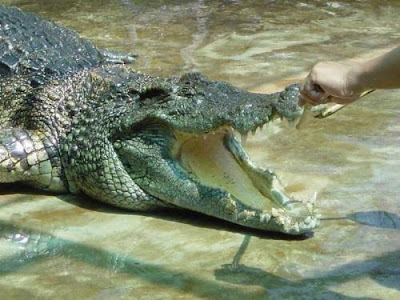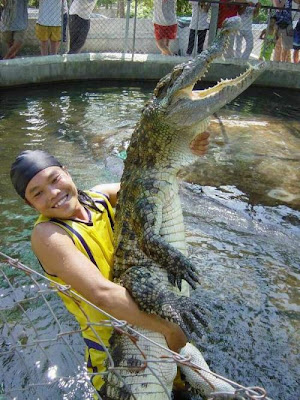Pet Crocodile










How Great is the Amazon River?
 |
The Amazon is the greatest river in the world by so many measures; the volume of water it carries to the sea (approximately 20% of all the freshwater discharge into the oceans), the area of land that drains into it, and its length and width. It is one of the longest rivers in the world and, depending upon who you talk to, is anywhere between 6,259km/3,903mi and 6,712km/4,195mi long.
For the last century the length of the Amazon and the Nile Rivers have been in a tight battle for title of world's longest river. The exact length of the two rivers varies over time and reputable sources disagree as to their actual length. The Nile River in Africa is reported to be anywhere from at 5,499km/3,437mi to 6,690km/4,180mi long. But there is no question as to which of the two great rivers carries the greater volume of water -the Amazon River.
Because the Amazon drains the entire Northern half of the South American continent (approx. 40% landmass), including all the torrential tropical rains that deluge the rainforests, it carries an enormous amount of water. The mouth of the Amazon River, where it meets the sea, is so wide and deep that ocean-going ships have navigated its waters and traveled as far inland as two-thirds the way up the entire length of the river.
 of the natural world. Have you ever seen a catfish? They're usually found in warm, slow moving waters of lakes and streams, and some people keep them as pets in aquariums. Catfish are pretty creepy looking fish with big flat heads and "whiskers" on either side of their heads (hence the name, catfish). Most catfish that we're familiar with here in the U.S. are anywhere from eight inches long to about five feet, weighing in at up to 60 pounds. But the catfish that live in the world's greatest river have all the room in the world to grow as big as nature will allow - they have been captured weighing over 200 pounds! One of the largest freshwater fish in the world is found living in the waters of the Amazon River. Arapaima, also known locally as Pirarucu,Arapaima gigas are the largest, exclusively fresh water fish in the world. They have been found to reach a length of 15 ft/4m and can weigh up to 440lbs/200kg. (Read about the biggest freshwater fish in the world.)
of the natural world. Have you ever seen a catfish? They're usually found in warm, slow moving waters of lakes and streams, and some people keep them as pets in aquariums. Catfish are pretty creepy looking fish with big flat heads and "whiskers" on either side of their heads (hence the name, catfish). Most catfish that we're familiar with here in the U.S. are anywhere from eight inches long to about five feet, weighing in at up to 60 pounds. But the catfish that live in the world's greatest river have all the room in the world to grow as big as nature will allow - they have been captured weighing over 200 pounds! One of the largest freshwater fish in the world is found living in the waters of the Amazon River. Arapaima, also known locally as Pirarucu,Arapaima gigas are the largest, exclusively fresh water fish in the world. They have been found to reach a length of 15 ft/4m and can weigh up to 440lbs/200kg. (Read about the biggest freshwater fish in the world.)Amazon River Facts
Largest Land Animal....
AFRICAN ELEPHANT
Loxodonta africana
· In one year an elephant can drink 15,000 gal/57,000 liters of water · Male elephants usually weigh about 16,500 lbs/7,425 kgs and are about 20 ft/6.1m long · Elephants have only FOUR teeth, which they can lose and replace up to six times · Elephants are herbivores, meaning they eat only plants and vegetation · African elephants can live as long as 70 years · Female gestation (length of pregnancy) in elephants is 22 months - almost 2 years! · Both male and female elephants have ivory tusks, which they use to dig for water, strip bark off trees, and the males used to 'spar' with each other
Elephants are very intelligent animals, with a sophisticated system of communicating. Like whales, they can create sounds that are outside the range of human hearing (calledsubsonic* sound). By blowing air through large chambers in their nasal passages they can create low rumbling sounds that can carry as far as five miles (8kms). No matter how loudly you screamed, even through a megaphone or a public address microphone, you couldn't be heard by another person five miles away! Being able to communicate with other groups of elephants helps the elephants to detect danger and warn others, as well as to find water, which is extremely scarce in some parts of Africa. African elephants are intelligent enough to be able to detect water flowing underground and have been seen digging up water in a riverbed that has run dry. Elephants really are amazing animals!!!!
The Story of the Angel Falls Discovery
 Angel Falls. Buy this poster at AllPosters.com |
The Natives in Venezuela had known about the "Salto Angel" since the beginning of time. Then United States pilot Jimmie Angel was flying over the area in 1935 when he landed on the top of a lone mountain in search of gold. His plane got stuck in the boggy jungle on top of the mountain and he noticed a pretty impressive waterfall plunging thousands of feet down. He wasn't too happy about the 11 mile hike back to civilization, and his plane remained stuck and rusting upon the mountain as a monument to his discovery. Soon the whole world would know about the falls, which came to be known as Angel Falls, after the pilot who "discovered" them.
Angel Falls plunges from the top of a mesa, or what the natives call a Tepuyi. Named "Auyantepui", the Angel Falls mesa is one of over a hundred of its kind which are scattered about the Guiana Highlands of southeast Venezuela. Like so many slumbering giants, what characterizes these mesas (Tepuys) is their massive heights soaring up towards the sky, each with a flat top and totally vertical sides (check out the picture at left). Also called "table mountains" (which accurately describes their shapes) these Tepuys were formed out of sandstone billions of years ago. Their vertical sides are continually being eroded by the action of water from the heavy rainfall the Guiana Highlands gets.
